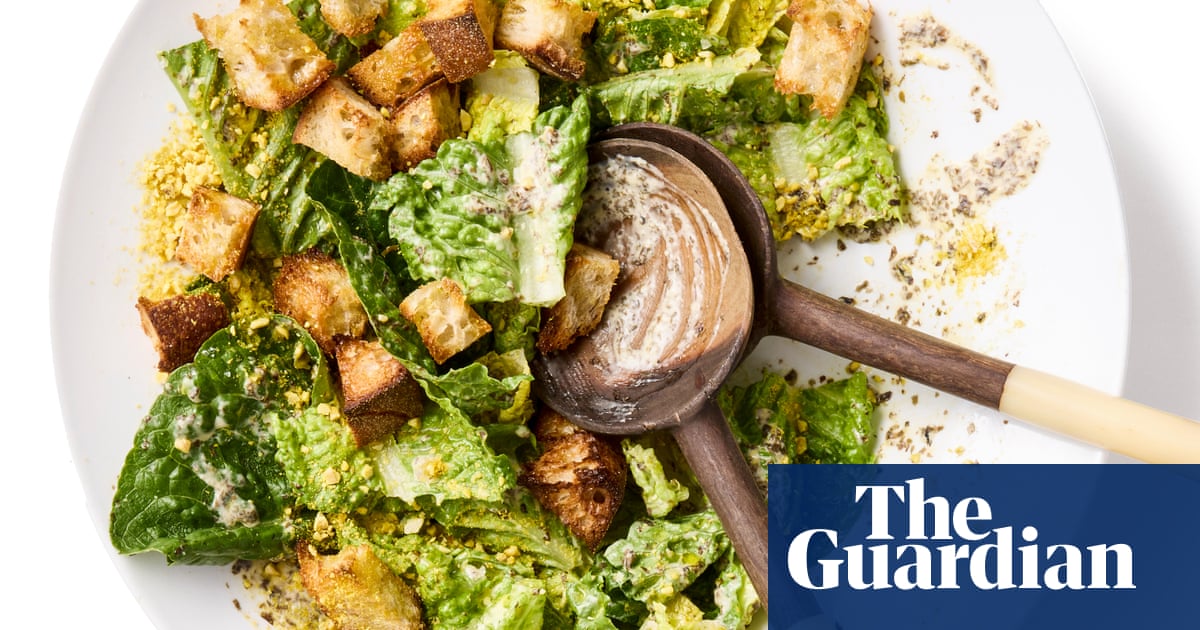The fried pickle – or frickle – is an on-trend appetiser with a murky provenance. Allegedly, it dates back to the early 1960s, originating at a drive-in restaurant in Arkansas run by an individual who laboured under the name Bernell “Fatman” Austin. Frickles are generally deep-fried, like onion rings, and usually accompanied by a gloopy dipping sauce such as aioli, dill and caper yoghurt or ranch dressing.
Frickles aren’t exactly new to the UK – they first started appearing on restaurant menus about a decade ago – but now they’re beginning to turn up at chippies. In January, Aldi launched a frozen version.
They’re also perfectly easy to make at home – there are even air fryer recipes out there – but what kind of pickle makes the best frickle? Armed with a deep-fat fryer and a whole lot of jars, I set about finding out.
For a snack with such a history, frickles don’t seem to have a definitive recipe. People cut their gherkins into all kinds of shapes and coat them in all kinds of ways: breaded, floured, battered, dipped in egg and cornmeal, or some combination of the above. The most important consideration for testing was to come up with a single method for comparison.

I settled on a compromise formula: a thick batter made of plain flour, cornflour, salt, pepper, paprika, bicarbonate of soda and fizzy water, followed by dredging in panko breadcrumbs. Then, after some trial and error, I ditched the breadcrumbs – they seemed like overkill – and added a pre-dredging in plain flour, which helped the batter adhere better.
There were two other things I figured out along the way: one, pickles are wet – really wet – and they need to be dried off with kitchen roll before battering, otherwise they’ll get soggy quickly. And two, frickles do not need a long cooking time. A minute or so in sunflower oil at 190C (374F) is generally enough to brown and crisp the outside, which is all you want. The pickles themselves don’t need cooking, and don’t benefit from it.
A word about pickled cucumbers: I may not know what the perfect frickle tastes like, but I know what the perfect pickle tastes like, and you can’t get them in the UK. Since I arrived here 35 years ago, I have searched for the British equivalent of an American kosher dill pickle, and there is simply no such thing. From time to time, I have been frustrated enough to make my own, which I recommend – it’s not hard. Here’s a simple recipe if you want to try it yourself.
I accept that this may be a question of differing cultural tastes, but if you’re going to deep-fry a pickle, it ought to be the right sort. So I’ve included one American import as a control, and the rest here are, at best, rough approximations. Let the second-best pickle win.

Polish Specialties ogórki konserwowe (pickled cucumbers)
These whole gherkins are of a size – 9-10cm, roughly – that means they’re best cut in half lengthways before frying. The balance of sweet and sour is perfectly acceptable (although, like almost every pickle tested, they err on the sweet side), but there is no hint of any kind of spice, or of the dill that is resting at the bottom of the jar.
The crunch, however, is good, and holds up under well after being battered. They’re a little bland – they seem to be holding on to a lot of water – but they result in a decent enough frickle. (6/10)
Freshona sliced gherkins
Freshona is a Lidl brand, and these were chosen primarily for the way they’re cut: lengthwise slices, about 5mm thick. I thought this might confer some advantage when frying, but it actually leaves the slices floppy and crunchless. They’re also disappointingly sweet, with no detectable spice. Once deep-fried, they taste of almost nothing at all. (3/10)

Rolnik ogórki kwaszone (brined cucumbers)
I found this jar in a local shop, not quite knowing what I’d got my hands on. These large gherkins are sort of an outlier, as they contain no vinegar at all. They’re preserved only in salt water and then – I’m presuming – fermented (the water is a little bit cloudy). So they’re sour, but with none of vinegar’s acidic edge. In that sense, they’re not really pickles as we understand them.
But you know what? They make really good frickles; the gherkins are fat enough to be cut into quarter spears and still maintain an optimal batter-to-pickle ratio. They’re also very salty, with a very satisfying crunch, retaining both qualities once deep-fried.
If there were any kind of frickle governing body these may well be disqualified, but they make for a tasty beer accompaniment and I certainly preferred them to a lot of the traditional gherkins tested. (7/10)
Morrisons crinkle-cut pickled gherkins
A lot of people would tell you that the crinkle-cut disc – a classic hamburger pickle – is the ideal shape for a frickle. Again, there is no governing body, but this makes sense: certain lore suggests that frickles were invented accidentally when hamburger pickles fell into the onion-ring batter at some fast-food outlet of yesteryear.
Unfortunately, in the UK at least, this shape usually heralds the most underwhelming pickle imaginable – sickly sweet and otherwise tasteless. This Morrisons own-brand version is better than many I’ve tasted – not too watery, with a fairly firm crunch but with a little too much sugar. The crinkle cut does indeed make a good frickle, with a surface area that seems to hold on to a bit more batter. They need a thorough drying before you fry, but they come out crispy and bite-size. (7/10)

Opies cornichons
To be honest, this choice seemed like a bit of light relief – cornichons are a novelty mini-pickle and, while fun, are hardly suitable for our purposes. But these are lovely and sour, with a nice mustardy bite – easily among the best-tasting of the lot. They’re also tiny enough to deep-fry whole. They retain their impressive crunch, and the result is a revelation. Deep-fried cornichons are, as far I’m concerned, a thing. Possibly my thing. (8/10)
Krakus pickled dill cucumbers
Another Polish brand. From the outside the jar looking in, these appear to be the real deal – whole cucumbers with dill, slivers of garlic and mustard seeds. But they’re on the sweet side, and lack any real intensity. Oddly enough, they do fry up quite well: the finished product is salty, crunchy and, while lacking the requisite sourness, somehow improved by a good battering. Then again, what isn’t? (6/10)

Kühne
Nothing much to recommend these, apart from the claim on the jar that they are “No 1 in Germany”. There is a hint of heat there from the mustard, but otherwise they don’t stand out from the pack in any way. It’s the same sad story: too sweet, too bland, only a little bit crunchy. (4/10)
Mrs Elswood’s haimisha gherkins
The self-proclaimed purveyor of the nation’s number one gherkins, Mrs Elswood – the brand avatar of Empire Bespoke Foods Ltd – makes a lot of different pickles: burger, dill, sandwich, sweet and sour. These haimisha gherkins, however, seem to fit the bill for frickles. The name comes from a Yiddish word meaning homey and cosy, and they’re supposed to be based on a traditional Jewish recipe.
Mercifully, and almost exclusively for a UK supermarket pickle, they contain exactly the right amount of sugar: none. They’re firm and crunchy and, sliced in half the long way, they really stand up to deep-frying. If you want to produce an American-style frickle without importing an American-style pickle, this is probably as close as you’ll come. (9/10)
Sainsbury’s pickled gherkins
Lying somewhere between a small pickle and a large cornichon, these gherkins are amazingly, almost freakishly crunchy, and about the right size to batter whole. After a matter of seconds in the fryer they emerge crispy on the outside and still tumescent with crunch on the inside. Of course they’re too sweet, but a solid performer overall. (7/10)

Vlasic kosher dill spears
This isn’t the best American pickle, but it’s probably the easiest to come by in the UK. You can find them in some specialist shops or source them online, but the price is steep; the jar I ordered from Amazon cost me £9.99.
But this is what a dill pickle is supposed to be – sharp, sour and crunchy, without that cloying sweetness that spoils most UK gherkins. The spears – stubby cucumbers, quartered – are perhaps a little big for frickles, although lots of enthusiasts swear by them. My instinct – and I was proven right – was to halve them before proceeding.
Once battered and fried, their deep sourness provides the perfect contrast to the crisp outside; they’re crying out to be dipped in something mayonnaise based. But be warned: they’re incredibly salty, and that really comes to the fore after frying. You certainly don’t need any extra salt in your batter. Even so, no contest. (10/10)

 4 hours ago
7
4 hours ago
7













































